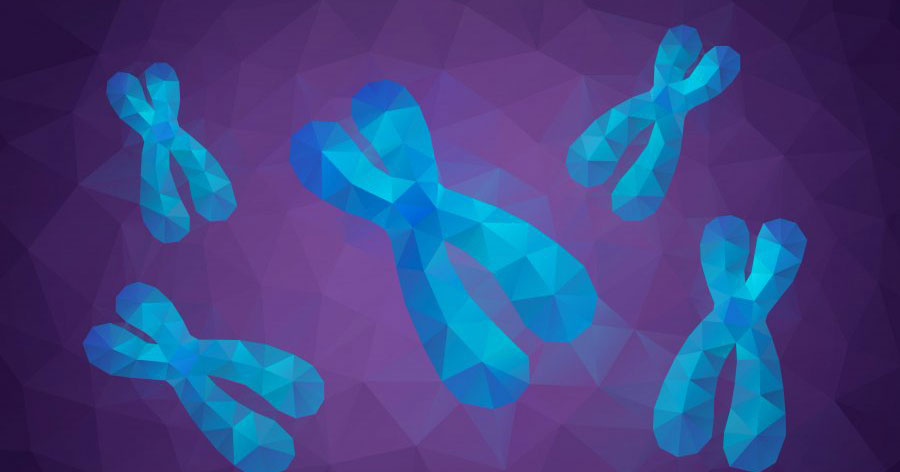
Adapted from a University of Alberta news release
Colorado State University biochemists have helped answer a fundamental question that has lingered since the discovery of DNA: Is chromatin – the complex package of DNA and proteins within the nucleus of our cells – a solid or a liquid?
In a study published in the journal Cell, a team co-led by Jeffrey Hansen, CSU professor in the Department of Biochemisty and Molecular Biology, found that chromatin behaves as a solid or gel, rather than a liquid. Hansen’s team collaborated with University of Alberta oncology professor Michael Hendzel on the study.
Previously, scientists assumed that chromatin and other elements of the nucleus operated in a liquid state. The team’s new insight into the physical properties of chromatin challenges that idea and could lead to more accurate understanding of how the genome is encoded and decoded.
The human genome, or complete set of genetic instructions, is structured into 23 pairs of chromosomes per cell, and all our chromosomes are made from chromatin, which is half structural histone proteins and half DNA. The DNA is organized into long strings with bead-like structures called nucleosomes. Inside the cell nucleus, chromatin fiber interacts with itself to condense into a chromosome. The chromatin fiber also supports gene expression and replication of chromosomal DNA. Although there is some understanding of the structures that make up a nucleus, how exactly those structures are organized, and the full extent of how the structures interact with each other, is not well known.
Biochemical, cell biology methods
Hansen has long been interested in how chromosomal structure influences its function, studying the behavior of chromatin in vitro. Methods his lab developed over 25 years have produced accurate models for studying chromatin and chromosome structures in test tubes.
To answer the solid or liquid question, Hansen’s team used biochemical approaches to determine the material state of condensed chromatin in vitro, in experiments conceived by paper co-author and CSU postdoctoral researcher Thomas Tolsma. The Hendzel lab used complementary cell biology approaches to determine the material state of chromatin in the nuclei of living cells.
“Whether a substance is a solid or liquid is a fundamental property that dictates how that substance functions,” Hansen said. “Our genomes are made out of condensed chromatin. Finding out that condensed chromatin is a solid will influence every aspect of how we think genomes store and express information, in both health and disease.”
Added Hendzel: “We all know the difference between water and ice, and we all understand that if you want to tie two things together, for example, you can’t do it with a liquid, you need a rope, something that has mechanical strength. That’s what we’re talking about here. Right now, all of our understanding of gene regulation is largely based on the assumption of freely moving proteins that find DNA and whose accessibility is only regulated by the blocking of that movement. So this research could potentially lead to very different kinds of ways of understanding gene expression.”
Deformability of chromatin
The team’s findings bridge 50 years of research on chromatin gels produced in the laboratory to demonstrate its existence in living cells, which has major implications for interpreting their elastic and mechanical properties, Hendzel explained. For example, recent studies have shown that the deformability of chromatin in cancer cells is an important determinant of their ability to squeeze through small spaces to travel outside a tumor and metastasize elsewhere in the body.
A better understanding of chromatin can also impact cancer diagnosis, said University of Alberta oncology researcher and paper collaborator Alan Underhill.
“The texture and appearance of chromatin is something pathologists have used to do clinical assessment on tumor samples from patients,” Underhill said. “It’s really looking at how the chromatin is organized within the nucleus that allows them to make insight into that clinical diagnosis. So now that’s a process that we can reframe in a new context of the material state of the chromatin.”
Answers to fundamental questions
The Hansen and Hendzel labs collaborated on the research to challenge another group’s previous contention that chromatin had liquid-like properties. Hansen noted that the results did not involve development of a new kind of technology, nor was it driven by DNA sequencing as is so common in today’s world.
“Rather, it was a beautiful example of how classical biochemistry and cell biology can be combined to answer fundamental questions relating to cell structure and function,” Hansen said. “The work also demonstrates how much basic research still needs to be performed to understand how our genome functions.”
The research was supported by grants from the National Science Foundation, the Canadian Institutes of Health Research, and the Cancer Research Society.
The Department of Biochemistry is in the College of Natural Sciences.